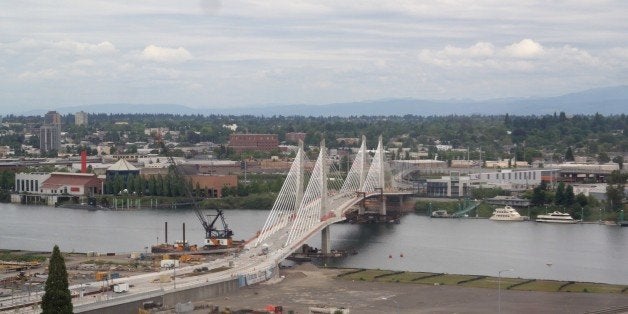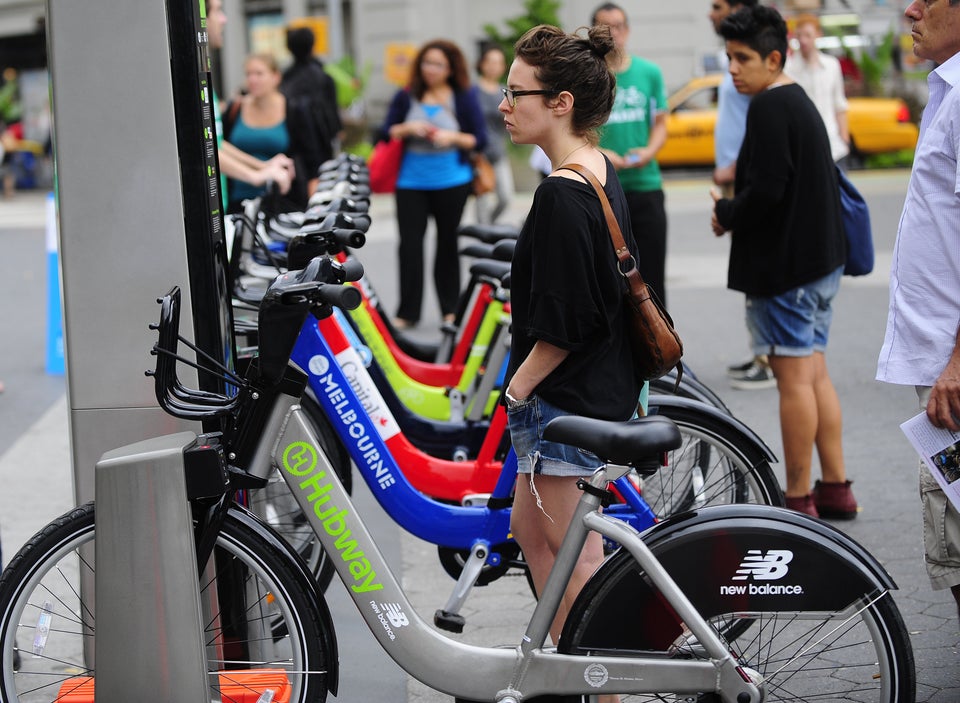
Like with craft breweries, beard trim joints, and bike-friendly apartment developments, ask a Portlander what their favorite bridge is in town and you’re sure to get a variety of very opinionated answers.
Some might say the Hawthorne Bridge, an old-school truss (built in 1910, it’s the oldest vertical-lift bridge still in operation in the United States) with considerable bike traffic.
Others might be particularly fond of the Broadway Bridge (1913), a classic drawbridge that’s been done up in international orange (aka “Golden Gate Red”) since the early 1960s.
Some might be torn between the simple charms of another bascule beauty, the Burnside Bridge (1926), and the St. John Bridge (1931), a showy steel suspension bridge with can't miss 'em Gothic towers that rise above the Willamette River at the city's northern edge.
Other Portland residents might be members of the Steel Bridge (1912) fan club. Although this unostentatious double-decker truss bridge isn’t the oldest vertical-lift bridge in the U.S. (that honor goes to the Hawthorne Bridge), it’s certainly the most versatile — a true multimodal marvel that The Oregonian once deemed as the “hardest working” bridge on the Willamette: “Cars, trucks, freight trains, buses, Amtrak, MAX, pedestrians, bicycles — you carry it all.”
The Steel Bridge, however, will soon be getting some serious competition in the multimodal department in the form of Tilikum Crossing, Bridge of the People. Due for completion in the fall of 2015 at an estimated cost of $134.6 million, Tilikum Crossing is the first Willamette River-traversing bridge to be built in the Portland metro area since the double-deck tied-arch Fremont Bridge opened to traffic in 1973. When Tilikum Crossing officially opens for business it will accommodate city buses, MAX Light Rail, the Portland Streetcar, cyclists, pedestrians, and unipipers.
Notice something missing from that list?
Tilikum Crossing will not be open to private cars and trucks (emergency vehicles are permitted) making it the longest —17,000 glorious, gridlock-free feet — car-less transit bridge in the U.S.
Sorry other Portland bridges, but it looks like in a year or so you may be bumped from the top of many a “favorite” list.
In a fantastic recent piece for CityLab, writer Brian Libby chatted with Dan Blocher, executive director of capitol projects for TriMet, along with transportation experts about Bridgetown’s newest addition, which, as it turns out, started out as more of a straightforward light rail project known as the Portland-Milwaukie Light Rail Bridge before evolving into something much bigger (but not necessarily wider). Just last week, regional transit authority TriMet pulled a MAX train over the bridge as part of a test safety run to ensure that trains actually fit on the new light rail line that spans across the bridge.
(Bridge geeks note: Tilikum Crossing is a slender example of a somewhat ubiquitous four-pier cable-stayed bridge with two 14-foot-wide pedestrian and bike paths flanking the bridge’s trackway and roadway sections.)
"It's an act of urban planning maybe even more so than a transit project," Blocher tells CityLab of the sprawl-limiting span nestled between the Marquam and Ross Island Bridges in South Portland's South Waterfront area. Situated on a large swath of former industrial land, South Waterfront is a high-rise-heavy residential "eco-district"/urban redevelopment project that prides itself on its green housing options, its farmers market, and its myraid public transportation offerings.
While there are indeed roads leading in and out of South Waterfront, also home to a new campus for Oregon Health & Science University (OHSU), transit officials opted to focus on bolstering light rail and streetcar service instead of building new roads to serve the dense and rapidly growing area. The Portland Aerial Tram — it’s one of only two commuter aerial tramways in the U.S., the other being New York City’s Roosevelt Island Tramway — also serves South Waterfront, connecting the riverside to OHSU’s main campus on Marquam Hill.
Suggested as part of a naming process in which the public was invited to submit ideas for names for the new bridge, "Tilikum Crossing, Bridge of the People" honors the region’s indigenous Chinook people; Tilikum is a Chinook word for people, tribe, family.
Chet Orloff, a Portland historian and chair of the Bridge Naming Committee, remarked that the name was selected out of four finalists as it showed, “the most promise to connect the people of our region today with the long past of people who have been here for thousands of years, and to connect with future generations.”
A major transit bridge project that welcomes pretty much everything but cars might seem unfathomable in other American cities of similar size and geography. However, it’s anything but atypical in Portland, a city which historically hasn't snubbed the automobile per se but has long prided itself on offering its residents alternative ways to get around town. In the 1970s, Portland famously began building its light rail network using federal highway funds from a proposed freeway project (Mount Hood Freeway) that was positively shut down by ouraged residents. At around the same time, Portland also welcomed a freeway removal project in which the old Harbor Drive was replaced with a popular downtown park along the Willamette. In 2001, a snazzy streetcar system joined MAX light rail as another transit option.
Says Blocher:
It's not for everybody. A lot of people like to drive their cars because of their scheduling needs or childcare needs or so forth. But for everyone who does ride the transit system, that's a car off the road. It has to be looked at as a total transportation system. And Portland is really the poster child on the integration of land use and transportation planning. People come from all over the world to study how it's done here.
